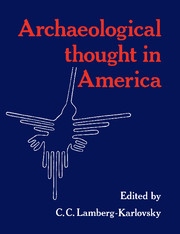Book contents
- Frontmatter
- Contents
- List of illustrations
- Introduction
- Part I History, method, and theory
- 1 History and contemporary American archaeology: a critical analysis
- 2 Aspects of the application of evolutionary theory in archaeology
- 3 The “New Archaeology,” then and now
- 4 Marxism in American archaeology
- 5 Formal approaches in archaeology
- 6 Ideology and evolutionism in American archaeology: looking beyond the economic base
- 7 The present and the future of hunter-gatherer studies
- 8 Paleopathology and the interpretation of economic change in prehistory
- Part II Archaeology in the Americas and beyond
- References
- Index
5 - Formal approaches in archaeology
Published online by Cambridge University Press: 06 July 2010
- Frontmatter
- Contents
- List of illustrations
- Introduction
- Part I History, method, and theory
- 1 History and contemporary American archaeology: a critical analysis
- 2 Aspects of the application of evolutionary theory in archaeology
- 3 The “New Archaeology,” then and now
- 4 Marxism in American archaeology
- 5 Formal approaches in archaeology
- 6 Ideology and evolutionism in American archaeology: looking beyond the economic base
- 7 The present and the future of hunter-gatherer studies
- 8 Paleopathology and the interpretation of economic change in prehistory
- Part II Archaeology in the Americas and beyond
- References
- Index
Summary
In this chapter I offer some methodological and theoretical perspectives on the current state of formal methods in archaeology. Such methods are often referred to as “quantitative,” but that term is inappropriate for several reasons. It is difficult to do anything archaeological that is not “quantitative” in the sense that counts or measurements of something are made and discussed. However, work that does not go much beyond simply tabulating and inspecting some numbers, although often very useful, is not what I have in mind. Doran (1986:21) defines formal methods as “mathematical, statistical and computer-based,” and says that “rather than being merely quantitative, formal methods are characterised by a combination of abstraction, systematisation and exactness.”
I will begin by summarizing important points in an earlier review of this topic (Cowgill 1986). The tone of my earlier chapter was predominantly critical. In this chapter I will try to get that part over with quickly, and turn, in a more positive mood, to some approaches that I think will repay more attention in the near future.
In my earlier chapter I proposed that we structure our thinking in terms of three broad categories: archaeological observations (that is, data), analytical methods (which provide connections between observations and theory), and sociocultural theory (Cowgill 1986:369). I said that mathematical and formal techniques mostly belong in the category of analytical methods, and while there is room for improvement in these techniques, what is most needed is better sociocultural theory, improved data, and better understandings of the connections between archaeological evidence and past behavior (that is, better “middle-range” theory) (Cowgill 1986:370, 390).
- Type
- Chapter
- Information
- Archaeological Thought in America , pp. 74 - 88Publisher: Cambridge University PressPrint publication year: 1989
- 6
- Cited by



